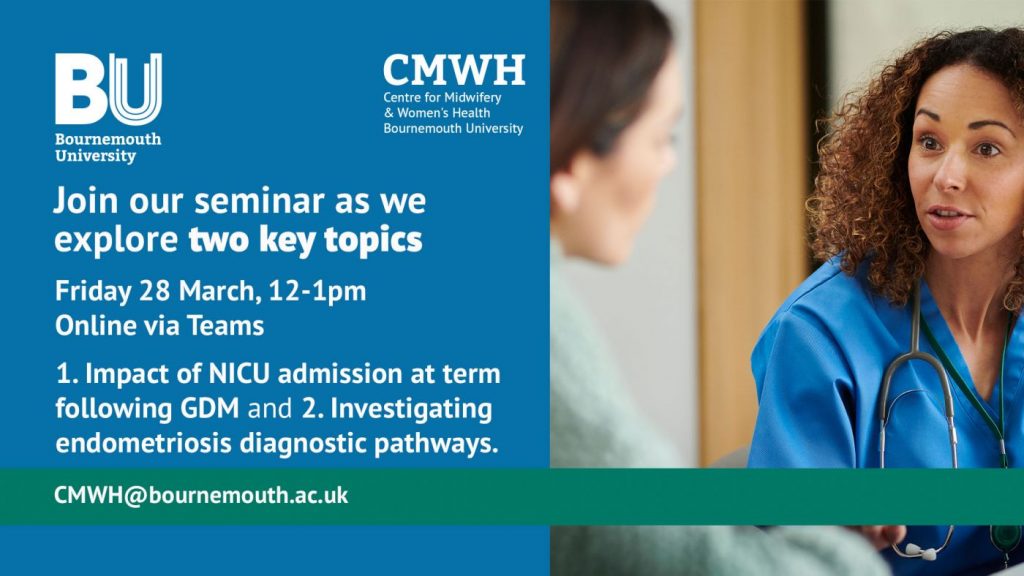
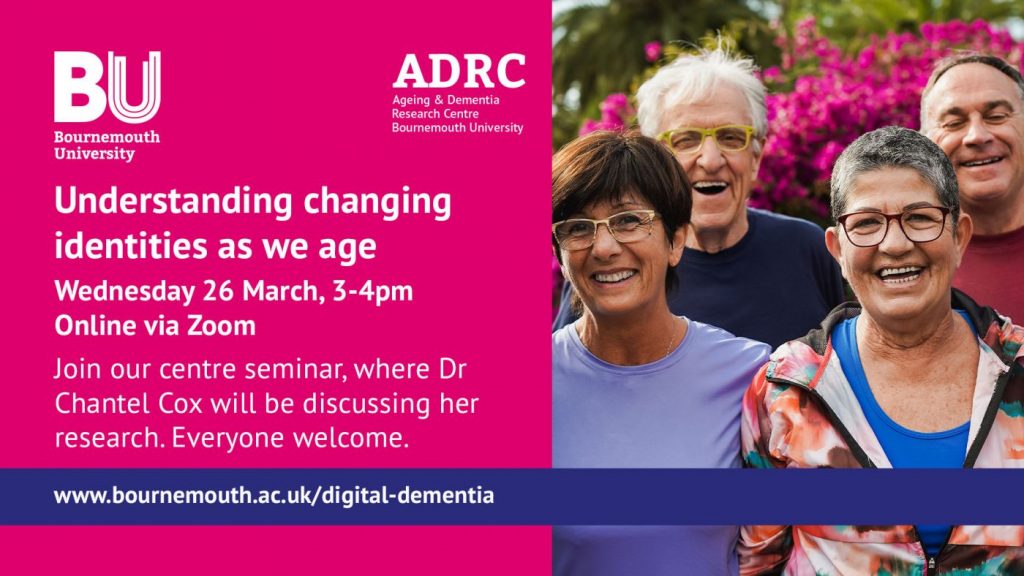


Latest research and knowledge exchange news at Bournemouth University




Do you have a question about BRIAN or your staff profile page? Then come along to the next BRIAN drop-in surgery!
Come along to this informal 2-hour drop-in surgery with questions or issues relating to BRIAN, or if you need a refresher on how to update your profile.
No booking is required, just bring your laptop and questions!
The call for applications for Being Human Festival 2025 is now open
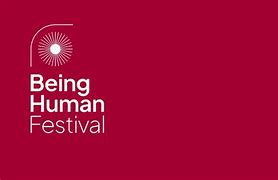 Being Human is the UK’s national festival of the humanities. Each year researchers and staff from universities and research organisations are invited to take part in the national festival by organising a public engagement event or activity, rooted in humanities research.
Being Human is the UK’s national festival of the humanities. Each year researchers and staff from universities and research organisations are invited to take part in the national festival by organising a public engagement event or activity, rooted in humanities research.
This year’s festival will take place 6-15 November with the theme ‘Between the Lines’.
Being Human is a place-based festival that emphasises interaction, collaboration and engaging with communities outside higher education. The festival supports innovative, participatory and creative activities that foster genuine, two-way connections with communities.
You can get an idea of what the festival looks like, and the types of activities they support, in the 2024 highlights film, and by reading the 2024 highlights blog.
There are various ways to participate in the festival:
Funded pathway
Festival Event Grants: up to £4,000 to organise a single event or multiple events. Deadline: Thursday 10 April Being Human 2025 – Festival Event Grant – Further Information.pdf
Please note: only applicants from UK Higher Education Institutions and AHRC-recognised IROs are eligible to receive grants.
Unfunded pathway
Festival Event: organise a festival event that does not require funding from Being Human. Deadline: Friday 4 July
Funding details and support available
Further details about how to apply, and answers to some frequently asked questions, are available here.
Training Programme 2025
The full training programme for 2025, has sessions running from February to October. This year’s programme includes new events on engagement and inclusion and creative engagement, alongside sessions on audiences, partnerships, promoting events and delivering events.
The sessions are led by expert facilitators, alongside members of the Being Human Festival team. Training is primarily aimed at those taking part, or thinking of taking part, in Being Human Festival, but will be of interest to those working in public engagement more broadly.
All sessions are free and take place online, but booking is required. Find out more and book individual sessions.
Toolkits
The Public Engagement Toolkits have recently been updated. These downloadable PDF resources cover subjects including working with partners, delivering inclusive activities and finding the right format. Browse the toolkits
Contact
Should you require advice on public engagement activities or support with your application, please contact BU’s Public Engagement with Research Team: publicengagement@bournemouth.ac.uk
 Today, Saturday morning, BU Visiting Professor Padam Simkhada from the University of Huddersfield was guest speaker at the third Nepal Dialogue UK webinar series of the Centre for Nepal Studies UK (CNSIK). His presentation was titled Is Nepal’s Health System fit for Purpose? Reflections on Transformations, Maladies and Future Needs. He outlined the state of health (epidemiology) as well as that of the health system. He presented a lot of change in the health of the population, in the health system, as well as issues around human resources, including the high rate of migration of health workers. He highlight that there is in Nepal insufficient investment in health, unethical practices,
Today, Saturday morning, BU Visiting Professor Padam Simkhada from the University of Huddersfield was guest speaker at the third Nepal Dialogue UK webinar series of the Centre for Nepal Studies UK (CNSIK). His presentation was titled Is Nepal’s Health System fit for Purpose? Reflections on Transformations, Maladies and Future Needs. He outlined the state of health (epidemiology) as well as that of the health system. He presented a lot of change in the health of the population, in the health system, as well as issues around human resources, including the high rate of migration of health workers. He highlight that there is in Nepal insufficient investment in health, unethical practices,
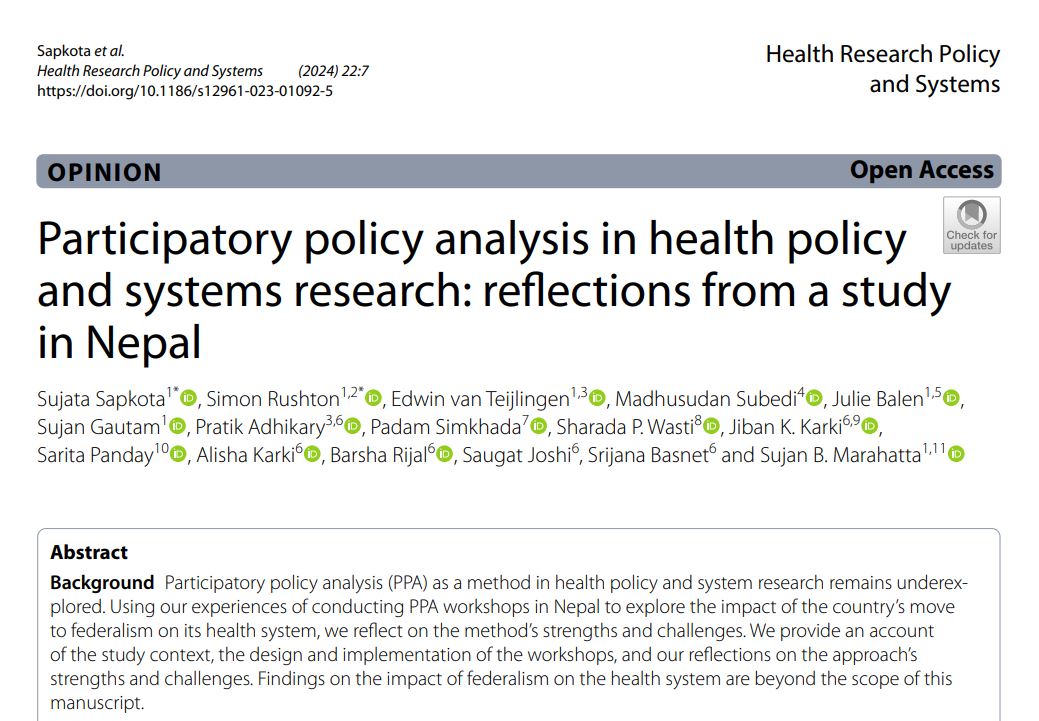 He introduced some the key findings from our recently completed study on the effects of the federalisation process on Nepal’s health system. Padam was one of the co-applications on this study together with academics from the University of Sheffield, Canterbury Christ Church University and Bournemouth University in the UK, and colleagues in Nepal from Manmohan Memorial Institute of Health Sciences (MMIHS) and PHASE Nepal. The project was funded by the UK Health Systems Research Initiative (Grant ref MR/T023554/1). For more information on the Nepal Federal Health System Team, see: https://www.nepalfederalhealthsystem.com/. This interdisciplinary study has been disseminated in the form of eight published papers [1-8].
He introduced some the key findings from our recently completed study on the effects of the federalisation process on Nepal’s health system. Padam was one of the co-applications on this study together with academics from the University of Sheffield, Canterbury Christ Church University and Bournemouth University in the UK, and colleagues in Nepal from Manmohan Memorial Institute of Health Sciences (MMIHS) and PHASE Nepal. The project was funded by the UK Health Systems Research Initiative (Grant ref MR/T023554/1). For more information on the Nepal Federal Health System Team, see: https://www.nepalfederalhealthsystem.com/. This interdisciplinary study has been disseminated in the form of eight published papers [1-8].
Prof. Edwin van Teijlingen
CMWH
References:
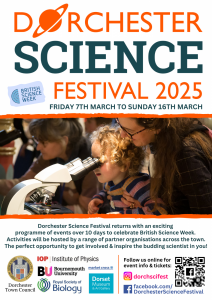
BU is a key partner in Dorchester’s annual celebration of science during the British Science Week (7-16 March 2025), significantly contributing to its success and educational impact. The Dorchester Science Festival features diverse scientific events, culminating in the Family Science Day on Sunday, March 16th, at the Dorset Museum & Art Gallery.
The university’s involvement brings valuable research expertise and hands-on learning experiences to attendees of the Family Science Day, contributing to the 24 science stalls on offer. BU staff and students actively share their research with children and families, representing various fields including Neuroscience and virtual reality (MINE Research Cluster, Xun He, Fred Charles Charles and Damla Kuleli); Forensic Sciences (Richard Paul and Nikky Jones); Biomedical Sciences (Anna Mantzouratou and Sarah Upson); Biological Sciences (Demetra Andreou); Marine Conservation (Jocelyn Elson-Riggins); Microbial Ecology (Genoveva Esteban).
These presentations offer hands-on activities for visitors of all ages, increasing BU’s visibility in the local community while promoting understanding of scientific issues and encouraging interest in STEM fields. BU’s involvement demonstrates its commitment to widening participation in science and creating positive impact in the community, helping to make the Dorchester Science Festival an engaging and educational event that inspires future generations of scientists and fosters connections between academia and the public.
Professor Genoveva Esteban from the Department of Life and Environmental Sciences (SciTech) co-organises the Dorchester Science Festival and the Family Science Day in collaboration with the Town Council and others. The Dorchester Science Festival has been funded by the Royal Society of Biology, the Institute of Physics, Dorchester Town Council, Market Cross UK LTD and the Dorset Museum & Art Gallery.
Full programme of events can be found on the Festival’s facebook page. For more info, please contact Genoveva Esteban gesteban@bournemouth.ac.uk
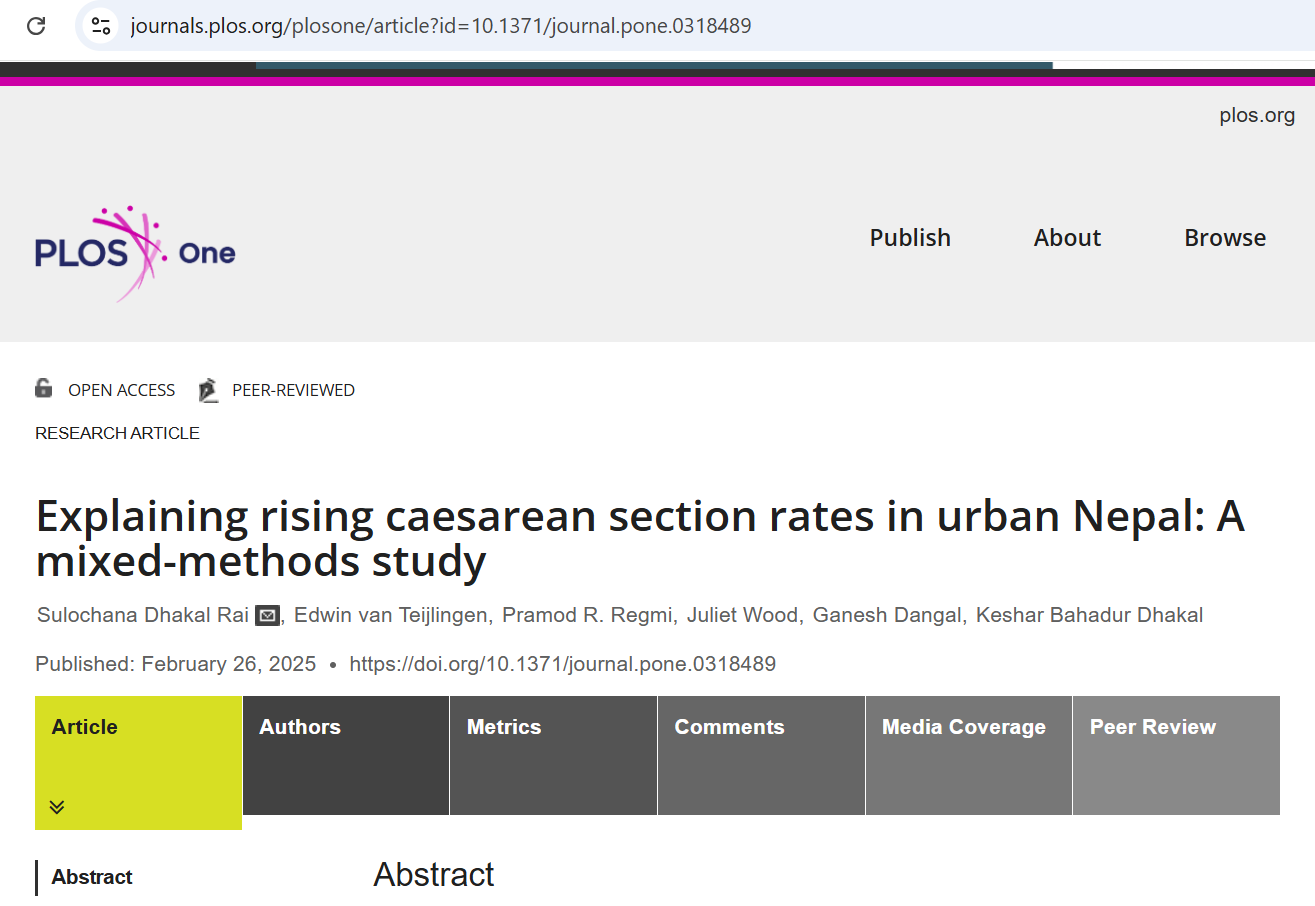
Yesterday the international journal PLoS ONE published the latest paper of former Centre for Midwifery & Women’s Health (CMWH) PhD student Dr. Sulochana Dhakal-Rai [1]. As in many countries, Caesarean Section (CS) rates are rising in urban hospitals in Nepal. However, the reasons behind these rising rates are poorly understood. Therefore, this study explores factors contributing to rising CS rates in two urban hospitals as well as strategies to make a more rational use of CS. Dr. Dhakal-Rai was supervised by Dr. Juliet Wood, Dr. Pramod Regmi and Prof. Edwin van Teijlingen all based in the Faculty of Health & Social Sciences.
The paper highlights that high CS rates in the private hospital reflects the medicalisation of childbirth, a public health issue which needs to be urgently addressed for the health benefits of both mother and baby. Multiple factors affecting rising CS rates were identified in urban hospitals. This study provides insights into factors affecting the rising CS rate and suggests that multiple strategies are required to stem the rise of CS rates and to make rational use of CS in urban hospitals.
The journal is Open Access and the paper is freely available to read in Nepal (and elsewhere) for anyone with internet access.
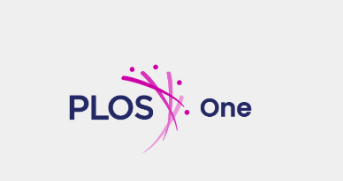
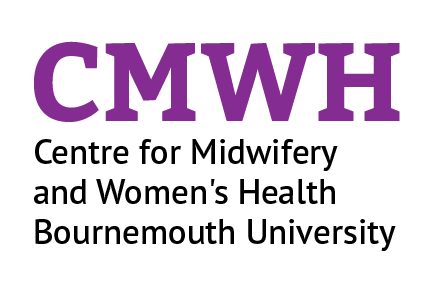
Reference:

The BU ECRN & RKEDF are delighted to offer funding to organise an event, roundtable, meeting, training, or workshop in support of research at BU.
This funding supports BU Early Career Researcher Network members to organise and facilitate an event that can be thematic, subject/discipline based, foster community engagement, knowledge exchange or networking and does the following;
– Brings ECRs and others together to share ideas, knowledge and learning.
– Provides a space for intellectual discussion.
– Helps to facilitate collaboration and future opportunities.
– Enables an opportunity for networking.
BU ECRN members can access up to £500 to organise and host an event, roundtable, meeting, training, or workshop at BU. Please see the requirements below.
Read about past successful applicants here: BU Research Blog | Early Career Researcher networking funding outcomes: A Tabletop Discussion on Cyber Signatures in Human Trafficking | Bournemouth University
– Please note all requests are subject to approval by the RKEDF Team and must be made at least 3 weeks in advance of the event date. No reimbursements for payments will be made without prior authorisation from the team.
– All expenses must be paid by the end of the BU financial year (July 2025)
– You will need to receive written confirmation from RKDEF that your request has been successful before you can proceed with organising the event.
– The event cannot have taken place prior to submitting your application.
Eligible costs
Ineligible Costs
How to apply:
Please download and complete all of the sections of the EOI for BU ECRN Funding 2425 (500 words max per section) and email your completed application to: RKEDF@bournemouth.ac.uk by 10th March 2025. Successful applicants will be notified by 17th March 2025.
If you have any questions or queries, please contact BU ECRN Academic Leads Ann Hemingway (aheming@bournemouth.ac.uk) and Sam Goodman (sgoodman@bournemouth.ac.uk) or RKEDF Advisor Joelle Fallows (jfallows@bournemouth.ac.uk).

Book now for RKEDF training in March 2025
Click on the titles to find further details and book your place
ECRN: Intellectual Property and Your Research
Tuesday 4th March 14:00-15:30 – online
Intellectual Property underpins academic research, as it is through Intellectual Property protection that we can protect, commercialise, and own our research & creative outputs. As researchers, we are constantly engaged in the works and products of others, all of which are underpinned and protected by Intellectual Property. We are also constantly creating our own outputs that can be protected by Intellectual Property. This workshop will explain the key areas of Intellectual Property that relate to academic research; how to protect your own Intellectual Property; and how to avoid infringing on the Intellectual Property of others.
Research Data Management: An introduction
Wednesday 5th March 12:00 – 13:00 – online
Attendance is recommended for any academic wishing to maximise the impact of their research data, and to learn how it can be managed through the research life cycle in a way that complies with research best practice and any legal, ethical or commercial requirements. It aligns with BU’s Research Data Policy, which closely reflects many funder and journal requirements.
Writing for The Conversation interactive workshop
Wednesday 5th March 14:00-16:00, in person, Talbot Campus
Learn how to consider the news potential of your expertise, how to look for story hooks and angles from the news, how to write a quality story pitch to section editors, and other advice. In this interactive session, you’ll find out more about communicating your research to the public, what The Conversation is looking for, and have the chance to discuss your research with a Conversation editor and pitch potential story ideas.
BRIAN – drop-in surgery – no booking required
Tuesday 11th March 14:00-16:00, F203, Fusion Building, Talbot Campus
This is a 2 hour drop in surgery for any questions or issues relating to BRIAN. No question is a stupid question so pop in and ask.
Wednesday 19th March 13:00-14:00, in person, Talbot Campus
This session is aimed at colleagues dealing with feelings of imposter syndrome in academia. The session will offer a space to discuss this growing issue as well as offer advice, guidance and support on how to manage, avoid and overcome such feelings. At the end of the session attendees will have achieved greater confidence in developing their career and profile. This workshop aimed at: All staff – Academic, teaching, research, professional services.
Principal Investigation – Post Award for RKE
Wednesday 19th March 13:00-14:30, in person, BGB, Lansdowne
This session is aimed at any researcher who is or plans to be a Principal Investigator for an externally funded research or knowledge exchange project. By the end of the session, attendees will have a strong foundation of what to expect when being responsible for their awarded projects. Topics covered include:
Wednesday 19th March 13:00-14:00, in person, Talbot Campus
Sometimes organisations can see an opportunity for growth, something that will supercharge their business, but they don’t quite know where or how to start. That’s when a Knowledge Transfer Partnership could help. We are hosting a series of developmental sessions for staff (and businesses) to debunk myths, provide insights, and forge connections. This session will focus on Fiduciary Responsibility and Evaluation of Company Accounts, Demonstration of Financial Strength, Suitability of Company Finances & Eligibility for KTP Scheme.
Links for further RKE information and support are below:
RKE SharePoint page: RKE – Home
RKEDF SharePoint for development opportunities: Research and Knowledge Exchange Development Framework RKEDF – Home
RKEDF Brightspace: Homepage – Research & Knowledge Exchange Development Framework
Please help us in avoiding any waste of resources; make sure you can attend or cancel your booking prior to the session. For any further information, please contact RKEDF@bournemouth.ac.uk
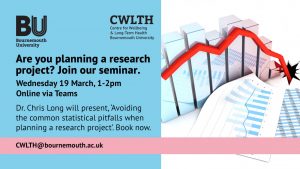
The Centre for Wellbeing and Long-Term Health‘s next Research Seminar and Centre meeting will be 13:00-14:00 on Wednesday 19th March. Dr Chris Long (Principal Academic on Healthcare Statistics) with be speaking about ‘Avoiding the common statistical pitfalls when planning a research project.’ For more information contact CWLTH@Bournemouth.ac.uk.
Professor Matthew Bennett and Dr Sally Reynolds write for The Conversation about their research at White Sands National Park, where they have found the earliest evidence of prehistoric transport…
Matthew Robert Bennett, Bournemouth University and Sally Christine Reynolds, Bournemouth University
If you’re a parent you’ve probably tried, at some point, to navigate the supermarket with a trolley, and at least one child in tow. But our new study suggests there was an ancient equivalent, dating to 22,000 years ago. This handcart, without wheels, was used before wheeled vehicles were invented around 5,000 years ago in the Middle East.
Recently our research team discovered some remarkable fossil traces which might give a hint. These traces were found alongside some of the oldest known human footprints in the Americas at a place called White Sands in New Mexico.
In the last few years, several footprint discoveries at this site have begun to rewrite early American history – pushing back the arrival of the first people to enter this land by 8,000 years.
There is some controversy around the age (23,000 years old) of these footprints, with some researchers unhappy with our dating methods. But they provide a remarkable picture of past life on the margins of a large wetland at the end of the last ice age.
The footprints tell stories, written in mud, of how people lived, hunted and survived in this land. Footprints connect people to the past in a way that a stone tool or archaeological artefact never can. Traditional archaeology is based on the discovery of stone tools. Most people today have never made a stone tool but almost all of us will have left a footprint at some time, even if it is only on the floor of the bathroom.
Today, modern shopping trolleys can be found rusting in canals, rivers or abandoned in shrubbery. But ancient versions would have probably been of wood and simply rotted away. We know that transport technology must have existed.
Everyone has stuff to transport, but we have no record of it until written histories. At White Sands, we found drag-marks made by the ends of wooden poles while excavating for fossil footprints. Sometimes these appear as just one trace, while at other times they occur as two parallel, equidistant traces.
A pole or poles used in this fashion is called a travois. These drag-marks are preserved in dried mud that was buried by sediment and revealed by a combination of erosion and excavation. The drag-marks extend for dozens of metres before disappearing beneath overlying sediment. They clip barefoot human tracks along their length, suggesting the user dragged the travois over their own footprints as they went along.
To help interpret these features, we conducted a series of tests on mud flats both in Dorset, UK, and on the coast of Maine, US. We used different combinations of poles to recreate simple, hand-pulled travois.
In our experiments the pole-ends dragged along the mud truncate footprints in the same way as the fossil example in New Mexico. These features in the fossil examples were also always associated with lot of other human footprints travelling in a similar direction, many of which, judging by their size, were made by children.
We believe the footprints and drag-marks tell a story of the movement of resources at the edge of this former wetland. Adults pulled the simple, probably improvised travois, while a group of children tagged along to the side and behind.
The research team has benefited from the insight of the Indigenous peoples we work with at White Sands, and they interpret the marks in this way as well. We cannot discount that some of the marks may be made by dragging firewood, but this does not fit all the cases we found.
Travois are known from historical documents and accounts of Indigenous peoples and their traditions. They were more commonly associated with dogs or horses, but they were pulled by humans in our tests.
As such they represent early examples of the handcart or wheelbarrow, but without the wheel. The earliest record of a wheeled vehicle dates from Mesopotamia (modern day Iraq), in 2,500BC. We think the travois were probably improvised from tent poles, firewood and spears when the need arose.
Maybe they were created to help move camp, or more likely, transport meat from a hunting-site. In the latter context the analogy with the shopping trolley comes to the fore, as does the pained expression of the adults faces as they quest for resources with a gaggle of children in tow.![]()
Matthew Robert Bennett, Professor of Environmental and Geographical Sciences, Bournemouth University and Sally Christine Reynolds, Associate Professor in Hominin Palaeoecology, Bournemouth University
This article is republished from The Conversation under a Creative Commons license. Read the original article.

This is a landmark collaborative initiative between BU’s NanoCorr, Energy and Modelling (NCEM) Research Group led by Professor Zulfiqar Khan and team members including Dr Adil Saeed, Dr Mayank Anand and Aerk Dimri and Lush Cosmetics Ltd a major stakeholder in the conurbation. “Born in Poole, Lush offers a range of quirky and unique handmade bathing and cosmetic products with signature ‘Lush’ scents. The brand boasts an extremely ethical promise to consumers with all products being cruelty free, vegetarian and ethically sourced.” [Source]. “Lush Limited is a British cosmetics retailer which is headquartered in Poole, England. It was founded in 1995 by trichologist Mark Constantine, his wife Mo Constantine and five other founders.” [Source].
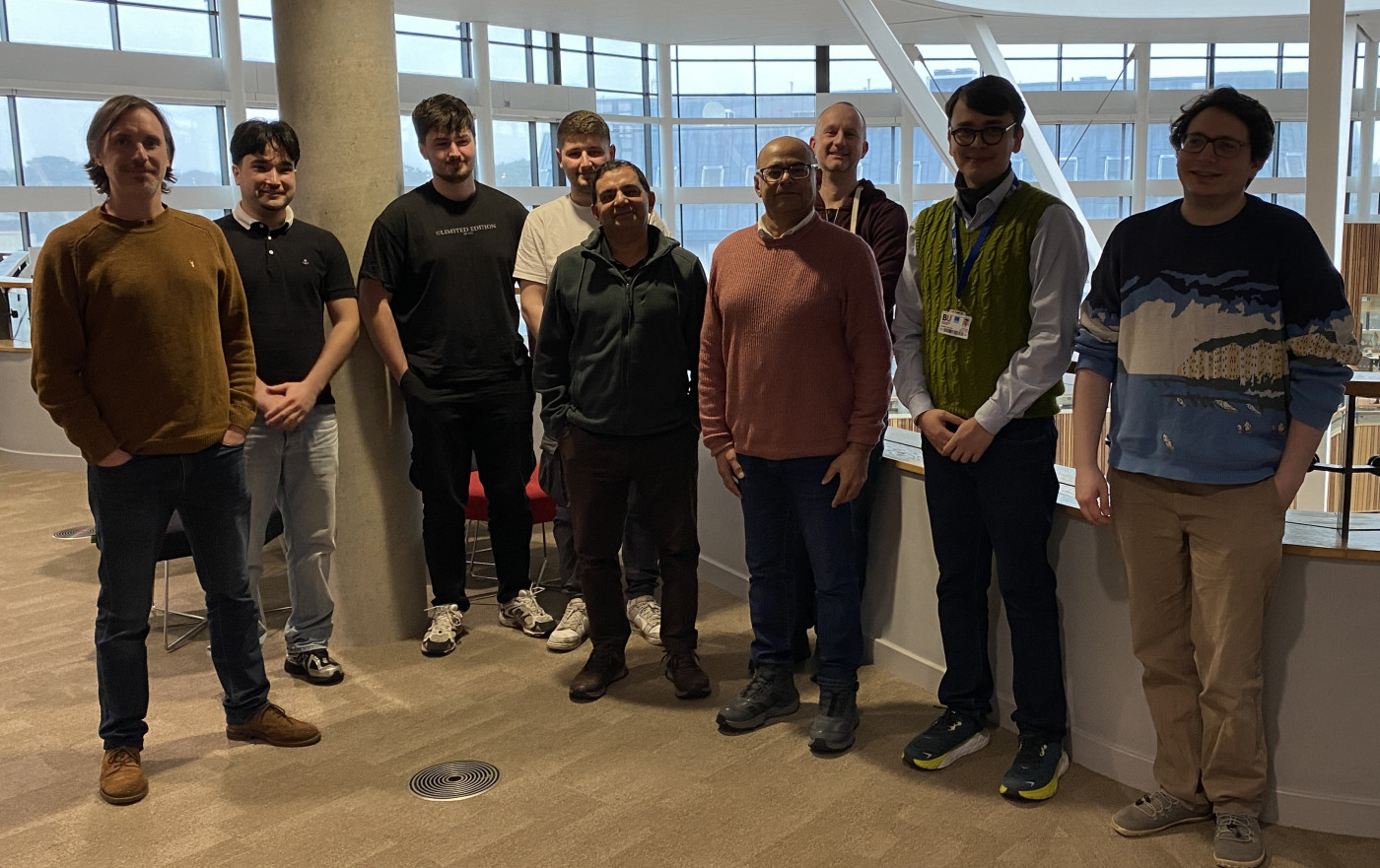
“We laid the foundation for capitalising on tidal energy sources and providing clean energy solutions for local and regional domestic and commercial applications through Community Interest Company (CIC) / Standard Industrial Classification (SIC), Poole Tidal Energy Partnership (PTEP), more than a decade ago, said Professor Zulfiqar Khan, one of the founding directors of PTEP.
This work led to UK based energy company collaboration in BU’s energy research: capture, conversion and storage through full funding of two PhDs, two Post Docs, one PhD in-kind support, industrial labs resources and funding patent applications, a three quarter of a million pound sterling research portfolio led by Professor Zulfiqar Khan. This has yielded in commercial patents in the US and GB, covering novel nano fluids, energy systems (capture, conversion and storage).
“This recent collaboration with LUSH is a testament of our full commitments to UNSDGs, UK and EU clean energy directives, initiatives which has led to emergence of BU as a global leader in Clean Energy Systems,” Professor Zulfiqar Khan added.
Dr Saeed said, “we provide opportunities for our UG/PGT courses to benefits from our research collaborations to enhance students learning and teaching experience through research informed educational provisions.” Dr Saeed, the Programme Leader of Mechanical Engineering course, said, we currently have three final year projects in energy systems which have been inspired and are linked to BU-LUSH collaborative project.
LUSH Creative Technologist Jim Woodward said, “We look forward to starting this journey with Professor Khan, his colleagues and students at Bournemouth University, researching the potential tidal energy in our beautiful Poole Harbour. We welcome the newly appointed PGR and wish him good luck in this exciting PhD project with us. What a force – Lush a local Poole company working with a fantastic local University.”

We are excited to host the Three Minute Thesis (3MT®) competition at BU for the very first time! Originally developed by the University of Queensland in 2008, 3MT® is an internationally renowned research communication challenge. It challenges doctoral researchers to condense their thesis into a compelling three-minute presentation, communicating its originality and significance to a non-specialist audience.
On Wednesday 26 March we will have four parallel sessions, one for each Faculty, to select the 2 finalists to advance to the final round, which will take place in the afternoon. The winner will take part in the national competition run by Vitae.
More information about the history of 3MT® can be found on the Vitae and 3MT® websites.
Eligibility
Active PhD and Professional Doctorate Research candidates who have successfully passed their Probationary Review (including candidates whose thesis is under submission/examination) by the date of their presentation (26 March 2025) are eligible to participate. Graduates are not eligible.
Please Note: MRes/MPhil students and students on interruption are NOT ELIGIBLE to enter the 3MT Competition.
Competition Rules
Make sure you read the international 3MT® rules before applying.
In order to allow all our P/T and remote PGRs to take part, if unable to attend in-person a pre-recorded video will be accepted, in line with the 3MT® rules.
Prizes
Key dates
Why should I take part?
Further information available on Brightspace.
Registration to attend will open in March.
Please do contact us if you have any questions: pgrskillsdevelopment@bournemouth.ac.uk
Best wishes,
The RDP Team
See Hidden Dorset at hidden.dorsetcommunityfoundation.org and read the story about the launch on their website here.
BU PIER are proud to have supported this and previous versions of the Hidden Dorset report. Special mention to Research Assistant Stevie Corbin-Clarke for all her help to gather initial data. Like DCF, we feel the report will be incredibly useful to groups and charities making a case for funding and identifying priorities and also to our research community in identifying local need. If you make use of it, please let us know, we would love to see how it is being used.
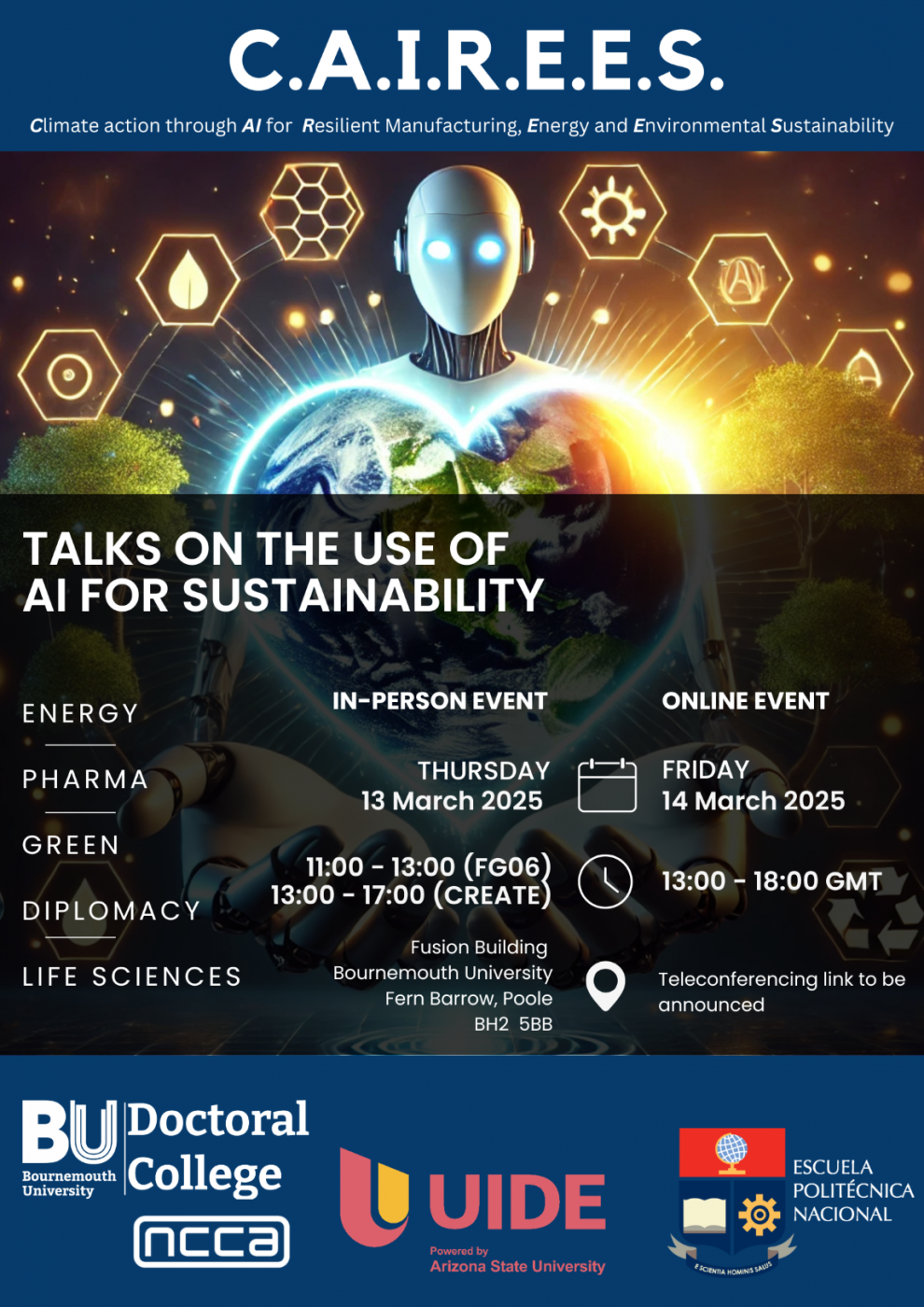
Harnessing AI for a Sustainable Future: Insights from Global Experts
BU is hosting the C.A.I.R.E.E.S. Conference – Climate action through AI (Artificial Intelligence) for Resilient Manufacturing, Energy and Environmental Sustainability – on Thursday 13 and Friday 14 March, in-person and online.
Through this conference, you’ll hear from global experts about how to harness AI for a sustainable future. It will explore how AI can support climate action in manufacturing, energy, and environmental sustainability.
This event, supported by the Doctoral College Research Culture and Community Grant, will bring together experts from academia, industry, and policy to discuss AI’s role in key areas, including energy, pharmaceuticals, green technologies, diplomacy, and life sciences.
The conference is open to all, whether you’re an AI researcher, industry professional, student, policymaker, or simply someone curious about how AI is tackling climate challenges.
Where and when
You can attend the conference in-person on Thursday 13 March, from 11am to 5pm in FG06 (Fusion Building). You can also participate online on Friday 14 March, from 1pm to 6pm.
During the event, attendees will have the chance to take part in a hands-on workshop, featuring a deep learning model applied to a real-world wildlife dataset. This is a great opportunity to explore AI applications in conservation and sustainability.
To book your place for either day, please complete this online form.
Keynote speakers and industry experts
The conference features speakers from the UK, US, Mexico, Ecuador, and beyond, reflecting the global nature of AI-driven sustainability efforts:
If you have any questions, please contact Kavisha Jayathunge: kjayathunge@bournemouth.ac.uk or Maria Alexandra Sandoval msandoval2@bournemouth.ac.uk.
Would you like to build a media profile and take your research to a global audience by writing for The Conversation?
Join Conversation editor Grace Allen for an in-person workshop at Talbot Campus on Wednesday 5th March to find out more about working with The Conversation and share your article ideas.
The Conversation is a news analysis and opinion website with content written by academics, researchers and PhD candidates working with professional journalists.
Since we first partnered with The Conversation, articles by BU authors have had over 11 million reads and been republished by news outlets across the world.
In this interactive session, you’ll find out more about communicating your research to the public, what The Conversation is looking for, and have the chance to discuss your research and pitch potential story ideas.
It runs from 2pm – 4pm in the Fusion Building on Talbot Campus.
Find out more about our partnership and the benefits of working with The Conversation
Congratulations to Dr. Karim Khaled on the latest paper from his BU Ph.D. research. This article ‘Ethical Issues and Challenges Regarding the Use of Mental Health Questionnaires in Public Health Nutrition Research‘ [1] was published earlier this month in the international journal Nutrients.
Karim is currently based at Birmingham City University, and the paper is co-authored with his Ph.D. supervisors Dr. Fotini Tsofliou and Prof. Vanora Hundley in BU’s Faculty of Health & Social Sciences. 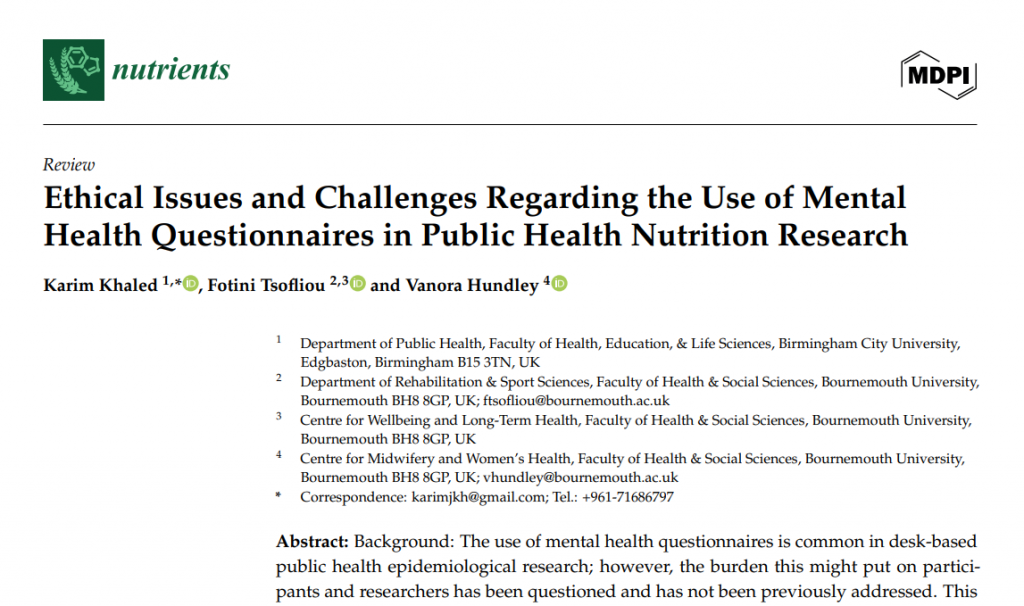 This paper addresses the potential burden of completing mental health questionnaires on (a) participants and (b) researchers. This examines ethical issues and challenges of using such scales and questionnaires, providing a real-life case study where the Beck’s Depression Inventory-II was used.
This paper addresses the potential burden of completing mental health questionnaires on (a) participants and (b) researchers. This examines ethical issues and challenges of using such scales and questionnaires, providing a real-life case study where the Beck’s Depression Inventory-II was used.
The ethical considerations raised by using mental health questionnaires in epidemiological research include incorrectly identifying participants as depressed or non-depressed; inability to identify participants for referral procedures due to the anonymous nature of some research studies; an increased burden on participants through depression and suicidal questions; and the high expectation of participants towards the researcher.  Preventative measures to reduce these challenges include choosing appropriate cut-off scores for correctly identifying participants; highlighting whether mental health questionnaires used may elicit negative emotional or psychological reactions related to suicide ideation; specifying the criteria for referral to clinical services; detailing the intended referral processes; including approaches where the researcher directly connects participants with a psychological service provider; and including a passive referral method such as contact details for participants to initiate their own referrals to clinical care. The authors offer a guide for researchers aiming to collect data on mental health through questionnaires, and they conclude that ethical challenges should be considered and reviewed at all stages of the research project.
Preventative measures to reduce these challenges include choosing appropriate cut-off scores for correctly identifying participants; highlighting whether mental health questionnaires used may elicit negative emotional or psychological reactions related to suicide ideation; specifying the criteria for referral to clinical services; detailing the intended referral processes; including approaches where the researcher directly connects participants with a psychological service provider; and including a passive referral method such as contact details for participants to initiate their own referrals to clinical care. The authors offer a guide for researchers aiming to collect data on mental health through questionnaires, and they conclude that ethical challenges should be considered and reviewed at all stages of the research project.
Well done!
Prof. Edwin van Teijlingen

Reference:
The future of the NHS is the subject of the first Spotlight Public Lecture delivered by Bournemouth University.
The Spotlight Public Lecture Series will shine a light on societal issues and areas of university strength, focussing on research conducted at the university and its real-world impact.
The first lecture will look at building an NHS fit for the future, featuring experts in women’s health, social care, and orthopaedics.
The event will be hosted at Royal Bournemouth Hospital from 5.30pm on Tuesday 18 March, with free tickets available. University Hospitals Dorset NHS Foundation Trust (UHD) CEO Siobhan Harrington will be opening the event.
Guests will hear from Professor Tom Wainwright, an expert in orthopaedics who also works at UHD; Professor Vanora Hundley, an expert in midwifery and women’s health; and Professor Lee-Ann Fenge, a leader in social work and care. The panel will each share their own research and how their work can help to inform future NHS plans and help people live better for longer.
Professor Sarah Bate, Interim Associate Pro Vice-Chancellor for Research and Knowledge Exchange at Bournemouth University, said, “I am always amazed by the work of our wonderful experts here at BU, who advance knowledge, solve societal issues and conduct research for a better future.
“I am excited for this first research-focused public lecture, centred around the health of the NHS – we want to see the NHS thrive and have academics actively working alongside NHS colleagues to support the health of people in the local area – I’m pleased that we’re able to share this research with you at this event.”
Future dates for events in the series will be announced shortly, with topics including tackling misinformation and the power of the past.
Tickets for the event can be reserved via Eventbrite: https://Spotlight-on-the-NHS.eventbrite.co.uk
For more information about the Spotlight Public Lecture Series, visit: www.bournemouth.ac.uk/spotlight-lectures
Bournemouth University (BU) and Mima, a human-centred design consultancy, have secured funding from the Defence Science and Technology Laboratory (Dstl) to collaborate on a Secure by Design (SbD) project. Dstl, the science and technology arm of the UK Ministry of Defence (MOD), provides critical expertise and solutions for national security.
The project will develop and evaluate a Minimum Viable Product (MVP) demonstrating how safety, security, and human factors analysis can be integrated into SbD requirements practices. This integration aims to improve the development of secure and effective systems for defence applications.
Professor Huseyin Dogan of BU’s Department of Computing and Informatics, a former BAE Systems scientist with eight years of industry experience, said: “Our department has a strong track record of collaborating with Dstl on match-funded PhDs focused on UK defence and security solutions.
“These projects span diverse areas, from automated risk-informed decision-making in electromagnetic interference to cyber resilience and safety analysis. This new project will integrate techniques from safety, security, and human factors to address complex defence challenges through innovative software tool support.”
Dr. Duncan Ki-Aries, Programme Leader for MSc Cyber Security and Human Factors at BU, added: “In today’s complex cyber landscape, understanding the human element and security challenges are crucial. However, in some scenarios, security concerns may also lead to safety concerns. This project allows us to explore how safety, security, and human factors concepts can be effectively integrated into secure design practices, leading to more robust systems and capabilities, and their safe and secure use of them.”
Dr. Eylem Thron, a Chartered Ergonomist and Principal Human Factors Consultant at Mima with experience in human factors and design across various industries, including rail and defence, said: “Mima is excited to bring our human-centred design expertise to this crucial project. By focusing on the needs and capabilities of users, we can help ensure that secure systems are also effective and usable in real-world scenarios.”
Dr. Shamal Faily, a Principal Scientist at Dstl added: “Within MOD, Secure by Design is a key enabler for delivering new capabilities at pace, given the cost and efficiency saving it could afford. To ensure we can properly ‘shift left’ and address security at the earliest stages of capability acquisition, this project will help us understand how coherence between security, safety, and human factors activities will help us identify security requirements early.”
The BU and Mima team bring expertise in Human Factors, Security, Systems of Systems Engineering, Safety and Risk Assessment, and is dedicated to supporting future defence capabilities through this Secure by Design collaboration.